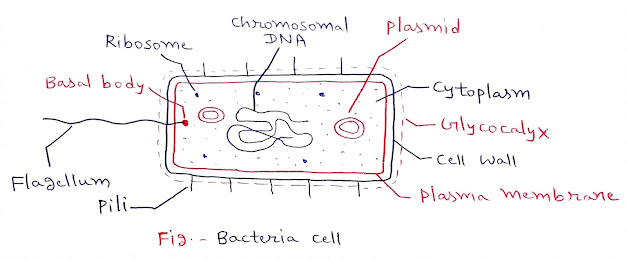Ultra structure of Eubacteria
Ultra structure of Bacteria:-
1. Glycocalyx:- This layer is present on the outer surface of cell wall. It is of 2 types -
a. Slime layer
b. Capsule
a. Slime layer:-
> It is an unorganised loosely associated extracellular layer that surrounds the bacterial cell wall.
> It is made up of glycoproteins, glycolipids and exopolysaccharides.
> Slime layers are amorphous in nature and are of varied thickness because they are produced depending on the cell type and environment.
> Because they are loosely associated with the bacterial cell wall, the slime layer can be easily washed off.
> Functions:-
i. It protects the bacterial cell from physical damage such as desiccation and antibiotics.
ii. It helps the bacteria in adhering to smooth surfaces.
iii. A slime layer is mainly composed of polysaccharides and hence is overproduced in unfavourable times as extra food storage for survival.
iv. It is also produced in soil dwelling prokaryotes to prevent them from unnecessary drying during annual temperature and humidity shifts.
v. It sometimes helps the bacteria to survive sterilisation by chemicals such as iodine and chlorine.
b. Capsule:-
> A bacterial capsule is an organised and tightly associated extracellular layer present around the bacterial cell wall.
> It is made up of simple sugars or polysaccharides.
> Unlike the slime layer, it is tightly packed and hence cannot be easily washed off.
> It can be found in both gram positive and gram negative bacteria.
> Function:-
i. The capsules are water loving (hydrophilic) and hence prevent the bacterial cell from water loss or desiccation.
ii. It also protects the bacterial cell wall from engulfment by the white blood cells (phagocytosis).
iii. The presence of a capsule in bacteria determines its virulence factor.
iv. It also helps the bacteria to adhere to various surfaces.
2. Cell wall:-
> It range in thickness around 0.02µ.
> It gives rigidity and shape to the bacterial cell.
> Chemical composition:- The three main constituents of cell wall are:
i. N-acetyl glucosamine (NAG)
ii. N-acetyl muramic acid (NAM)
iii. A peptide chain of four or five amino acids.
- These together form a polymer called peptidoglycan or mucopeptide.
- The NAG and NAM molecules which are arranged alternatively, run in one direction and the peptide chain run crosswise. The rigidity of bacterial cell wall is due to the presence of this polymer.
- Some other chemicals such as teichoic acid, Lipopolysaccharides are also deposited on it.
3. Plasma Membrane:-
> It is about 75 A° thick.
> Chemically it is composed of a double layer of phospholipid molecules.
> Proteins are found embedded in the lipid bilayers.
> Mesosomes:- The membrane has many folded structures called mesosomes which are associated with number of activities like -
i. Site for protein synthesis
ii. Respiratory function
iii. Multiplication of chromosomal DNA
> Plasma membrane contains special receptor molecules that help bacteria detect and respond to
chemicals in their surroundings.
> It also controls the entry of organic and inorganic molecules.
4. Cytoplasm:-
> It is a complex mixture of carbohydrates, proteins, lipids, minerals, nucleic acids and water.
> It stores organic material in the form of glycogen, rolutin and poly-β-hydroxy butyrate.
> The bacterial cell is devoid cell organelles but the photosynthetic bacteria have chromatophores in their cytoplasm.
> Ribosomes are the sites of protein synthesis and suspended freely in cytoplasm. Their number varies from 10,000 to 15,000 in a cell. Bacterial ribosmoes are 70s type (50s and 30s subunits) consists of two subunits.
5. Genetic material:-
a. Chromosomal DNA:-
> The dsDNA molecule is approximately 1,000 µm long, usually forming ring like structure or sometimes remain diffused throughout the cytoplasm of the cell.
> The Bacterial DNA is devoid of histones and referred to as bacterial chromosome.
b. Plasmids:-
> Lederberg (1952) gave the term plasmid.
> These are extra chromosomal ds circular DNA.
> They are self replicative.
> They contain different nonessential characters.
> Based on host properties, the plasmids are classified into different types as:
i. F - plasmid:- F-factor for fertility.
ii. Col - plasmid:- Col-factor for colicinogeny.
iii. R - plasmid:- R-factor for resistance.
iv. Ti - plasmid:- Tumor inducing plasmid (Agrobacterium).
v. Ri - plasmid:- Hairy root inducing plasmid (Agrobacterium).
6. Flagellation:-
> The organ of the locomotion is small whips or hair like appendages called flagella.
> Distribution of flagella:-
i. Atrichous:- Bacteia which lack flagella. Eg.- Lactobacillus
ii. Monotrichous:- One flagella at one end. Eg.- Vibrio chlolerae, Pseudomonas
iii. Amphitrichous:- One flagella at each end. Eg.- Nitosomonas, Spirillum
iv. Cephalotrichous:- Two or more flagella at one end only. Eg.- Pseudomonas fluorescens
v. Lophotrichous:- Tufts of flagella at both the ends, Eg.- Spirillum volutans
vi. Peritrichous:- Flagella distributed evenly all over the body, Eg.- Proteus vulgaris
> Structure of flagella:- The flagella is a helical structure composed of flagellin protein. The flagella structure is divided into three parts:
a. Basal body
b. Hook
c. Filament
a. Basal body:-
- It is attached to the cell membrane and cytoplasmic membrane.
- It consists of rings surrounded by a pair of proteins called MotB. The rings include:
i. L-ring:- Outer ring anchored in the lipopolysaccharide layer and found in gram +ve bacteria.
ii. P-ring:- Anchored in the peptidoglycan layer.
iii. M-S ring:- Anchored in the cytoplasmic membrane
iv. C-ring:- Anchored in the cytoplasm
b. Hook:-
- It is a broader area present at the base of the filament.
- It connects filament to the motor protein in the base.
- The hook length is greater in gram +ve bacteria.
c. Filament:- Thin hair-like structure arising from the hook.









